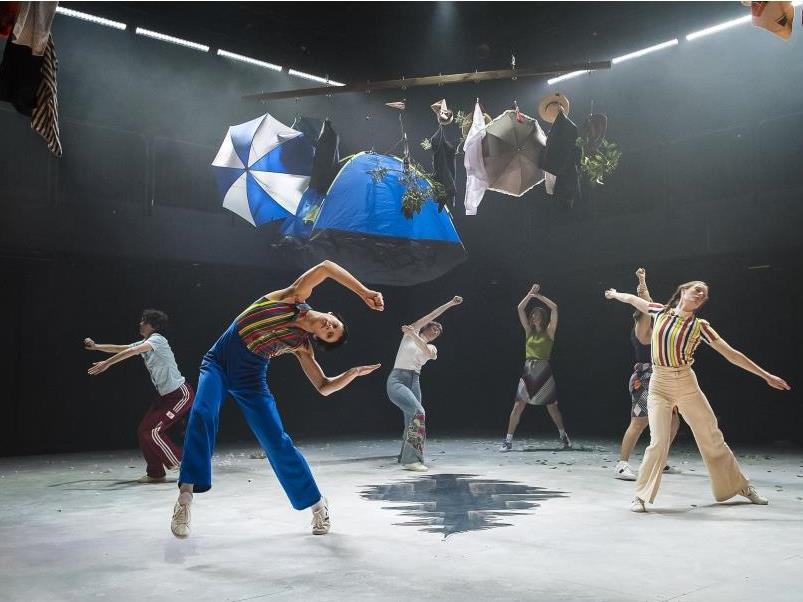A ‘performance without spectators’, WAISTD doesn’t allow its audience to sit back and watch. Image: Gregory Lorenzutti.
This review is being written on the day of the Global Climate Strike; slated to be one of the biggest civic protests in human history. The zeitgeist is screaming. Climate change is the most pressing issue currently facing humanity. No other issue has galvanised so many people – at a grassroots level – across political, geographic, demographic, economic, and cultural boundaries. So, it only makes sense that contemporary artists, of all creative disciplines, are diving headlong into the push, pull, and impact of climate change by, in, and on society. After all, isn’t this the role of the artist?
What Am I Supposed To Do (WAISTD), described as an ‘eco-horror,’ is the latest contribution to the burgeoning canon of Climate Change Art. It begins with a rehearsal of our own death – an acknowledgement of humanity’s shared fate – and continues as a collective, participatory journey through a curated cacophony of images, sounds, objects, choreographies, and spoken text. These elements act as sensory provocations, coalescing to produce an accumulative, immersive experience that places the audience at the heart of questions about individual and collective responsibility, about action and inaction, and about catastrophe, revolution, and survival.
Read: 5 ways the arts takes on the climate crisis
Audiences will experience this work in one of two ways: the first camp (a substantial number of people), will find themselves actively contributing to the choreographed chaos on stage – essentially a melange of humanity divided into familiar groupings, from corporate overlords to eco-activists. There were at least six of these groups, each with a lead artist and approximately eight audience participants. The lead artists guided their group through a series of movements, gestures, or routines, supported by props such as fans, apples, beach towels, sunhats, or foliage. The second camp (which I was in), will find itself on the viewing balcony of the Fairfax Theatre looking down upon this kaleidoscope of human groupings; trying to make sense of the patterns that emerge.
Read: How artists can survive climate anxiety
While it looked like fun to be a part of the on-stage anarchy, I was glad to be in a position which allowed a greater potential for seeing the meta-narrative by viewing it as a whole from above. The question of perspective is important in this work because, as the title suggests, the piece problematises the duality we all face as individuals in a collective system. On the one hand, we seek answers to the question ‘what is it I am supposed to do?’, and on the other, we are inextricably bound up in larger societal forces seemingly beyond our control, hurtling towards a collective Armageddon we may feel we can do nothing about. In WAISTD, what surfaces from this bifurcated perspective is an ambiguous and disconcerting cocktail of anger, hope, panic, recklessness, and ennui. I didn’t leave the theatre with any answers, but I did leave unsettled.
One of the most successful elements of this work is the wonderfully cinematic sound design by Andrew Wilson, which provides a much-needed cohesive force, cradling the on-stage tumult and contributing an emotional depth that sometimes felt missing among the performer pandemonium. Amelia Lever-Davidson’s lighting design was also a key factor in creating an immersive environment defined by a smorgasbord of contradictory feelings, from alarm to abandon. Romanie Harper’s minimal design included a marking on the stage floor which suggested a plethora of ideas, from a Rorschach inkblot, or a seismic imprint, to a cartographic view of a water catchment rapidly evaporating. The ambiguity of the marking offered an attractive counterpoint to some of the more literal imagery in the show.
As a ‘performance without spectators’ WAISTD was an engaging and fun experience. As a contribution to the global discourse about climate change, its overall impact is equivocal. But it is impossible to sit back and critically review an experience like WAISTD without being implicated in the larger problem of humanity’s capacity for rationalisation, compartmentalisation and, ultimately, indifference. The question could easily be directed at a reviewer. See you at the Climate Strike.
3.5 stars out of 5 ★★★☆
What Am I Supposed To Do
Presented by Arts Centre Melbourne Take Over! Commission, in association with Melbourne Fringe
Concept, choreography and performance: Sarah Aiken and Rebecca Jensen / Deep Soulful Sweats
Collaborating performers: Claire Leske, Megan Payne, Alexander Powers, Ngioka Bunda-Heath
Design: Romanie Harper
Lighting Design: Amelia Lever-Davidson
Mentor/Outside Eye: Mish Grigor
Sound Design: Andrew Wilson
18-22 September 2019
The Fairfax Theatre, Arts Centre Melbourne, VIC
Tickets $30-$35
Presented as part of Melbourne Fringe Festival, 12-29 September 2019





